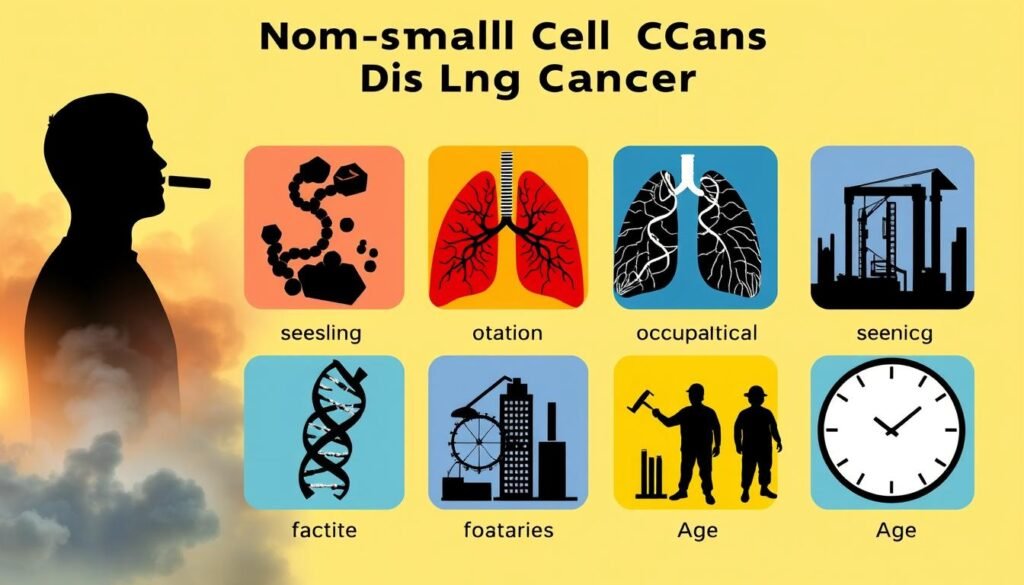Have you heard? The female-to-male ratio for tobacco-related lung cancer jumped from 0.88 to 1.17 between 1995-1999 and 2010-2014. This change among 30-50 year old non-Hispanic whites shows how lung cancer, especially Non-Small Cell Lung Cancer (NSCLC), is different for men and women. It’s vital to understand these differences because they affect how lung cancer is treated and the patient’s outcome.
Lung cancer used to be seen more in men, but now women are catching up. Women might also have different symptoms and ways of finding out they have cancer. Since NSCLC appears differently in men and women, we need specific methods for diagnosing and treating each gender. Also, fewer women in clinical trials means we might not know the best way to treat female patients.
Next, we’ll look more at how NSCLC is different for men and women. We’ll talk about what causes it, how it works in the body, the challenges of diagnosing it, and what the outcomes are. Our goal is to show why it’s so important to think about gender when treating lung cancer. This could help everyone with NSCLC live longer, better lives.
Key Takeaways
- The incidence ratio of tobacco-related lung cancer is now higher in women than men in certain age groups.
- Women face a growing incidence of lung cancer, particularly among non-smokers.
- Research indicates higher survival rates for women with NSCLC compared to men.
- Men are more likely to be diagnosed at later stages of lung cancer, affecting prognosis.
- Gender-specific factors influence the effectiveness of lung cancer treatments.
- There is a critical need for more research that includes female populations in clinical studies.
- Understanding biological differences can pave the way for tailored lung cancer therapies.
Introduction to Non-Small Cell Lung Cancer
Non-small cell lung cancer (NSCLC) makes up about 85% of all lung cancer cases. It includes types like adenocarcinoma, squamous cell carcinoma, and large cell carcinoma. Each type has unique features and treatments.
Adenocarcinoma is the most common, forming nearly half of the cases. Lung cancer is a top cause of cancer deaths in the U.S., with around 230,000 new cases and 135,000 deaths a year. Knowing how NSCLC develops helps guide treatments and improve patient lives.
The chances of getting lung cancer vary based on genes and environment. A study pointed out how genes affect lung cancer risk. This helps understand personal risk better.
Early detection of NSCLC is key for effective treatment. While Stage 0 might only need surgery, later stages could require chemotherapy and immunotherapy. Being informed about lung cancer helps those at risk take early action.
| Lung Cancer Stage | Treatment Options |
|---|---|
| Stage 0 | Surgery alone |
| Stage I | Lobectomy or smaller piece removal; lymph node evaluation |
| Stage II | Neoadjuvant chemotherapy followed by surgery |
| Stage IIIA | Combination of surgery, chemotherapy, radiation therapy, and immunotherapy |
| Stage IIIB | Chemotherapy with radiation therapy; targeted therapy as needed |
| Stage IVA | Personalized treatments including chemotherapy, radiation, and surgery |
| Stage IVB | Systemic therapy; treatment adapted based on overall health and treatment history |
Treatment strategies for NSCLC stages vary, reflecting the complexity of the disease. Research enhances early detection and treatment options. Insights into successful treatments are growing.
Understanding Gender Disparities in Lung Cancer
Lung cancer leads to more deaths worldwide than any other cancer, with 1.8 million in 2020. Studies show big gender disparities in how often it happens and the results of treatment. This issue involves biology, society, and the environment.
Though men were more affected before, now women are getting lung cancer more often. This change is a bit comforting. It shows how patterns can shift over time.
Adenocarcinoma is now more common in young women and those who never smoked. This goes against what was previously thought about lung cancer’s typical patients. However, women often find out they have the disease later than men do. This delay can lead to worse outcomes after treatment.
Even so, women have a slightly better chance of survival after diagnosis than men. But they’re much less likely to be in clinical trials, making up just 38.7% of them. The differences in risk, such as radon and cooking fumes, play a part too. Not enough women know about tests like the low-dose CT scan.
We must make health care policies that focus on these gender disparities. Women are facing lung cancer more now, so our strategies must get better. We need to understand how lung cancer, biological differences, and social factors all link together. Only then can we improve outcomes for everyone.

| Key Statistics | Men | Women |
|---|---|---|
| Lung Cancer Incidence | 27% higher compared to women | Increasing rates, particularly in never smokers |
| Presentation Stage | Earlier detection generally | Often diagnosed at advanced stages |
| Clinical Trial Participation | Higher representation | Only 38.7% of participants |
| Unique Risk Factors | Higher overall smoking rates | Radon exposure, indoor fumes |
| Treatment Outcomes | High mortality rate | Better outcomes post-diagnosis but more advanced stages |
Risk Factors for Non-Small Cell Lung Cancer
Understanding lung cancer risks, especially for non-small cell lung cancer (NSCLC), is crucial. Smoking is the top risk factor affecting both men and women. As smoking trends in women change, the need for specific interventions grows. Moreover, the risk for non-smokers, particularly women, is increasing. This highlights how the environment and lifestyle influence health.
Impact of Smoking on Gender Differences
Smoking greatly affects lung cancer rates, with about 80% of deaths due to smoking. This figure is even higher for small cell lung cancer. Changes in women’s smoking habits have led to more lung cancer cases in females. Similarly, smoking “light” cigarettes carries the same risks as regular cigarettes. Secondhand smoke is also a major concern, being the third leading lung cancer cause in the U.S.
Non-smoking Risk Factors Particularly Affecting Women
Even for non-smokers, lung cancer risks are increasing, especially for women. Radon exposure, second only to smoking, raises lung cancer risk for non-smokers. Working with asbestos and prior chest radiation therapy also up the chances. Not to forget, outdoor air pollution contributes to 1% to 2% of lung cancer deaths. These points stress the need for broad education on lung cancer risks beyond smoking. Such efforts should aim to lower NSCLC rates among non-smokers. For more details on NSCLC and its risks, visit this resource.

Biological Mechanisms Behind Gender Differences
Studying gender differences in lung cancer requires grasping Biological Mechanisms. This includes the roles of sex hormones and genetic variations. Together, they affect how the disease progresses and the results for patients.
Role of Sex Hormones in Lung Cancer
Sex hormones, like estrogen and testosterone, greatly influence lung cancer. Studies show that cancers more common in men have higher rates compared to women. Hormones play a big role in cancers like those of the breast and prostate. They show how hormone levels can drive cancer.
Genetic and Molecular Differences Between Genders
Men and women show Genetic Differences in Cancer, seen in their unique epigenetic profiles. Different methylation patterns in tissues like blood and liver offer deep insights. They help us understand cancer’s beginnings.
One finding is how neonatal female rats have more DNA methyltransferase Dnmt3a. This affects the methylation of the estrogen receptor (ER)-α gene. Knowing these differences helps create better treatments considering Biological Mechanisms in lung cancer outcomes.
| Factor | Male | Female |
|---|---|---|
| Incidence Rate | 1.26:1 to 4.86:1 | Lower overall incidence |
| Influence of Sex Hormones | Significant effect on lung cancer pathology | Responsive to estrogen and progesterone |
| Genetic Variations | Less pronounced epigenetic dysregulation | Distinct sex-specific methylation patterns |
It’s key to understand these Biological Mechanisms to improve lung cancer treatment for both genders. More research will help us see how these factors affect the disease. This guides us toward personalized treatment methods.
Gender-Specific Symptoms and Diagnosis Delays
Lung cancer is a major health issue that affects men and women differently. It’s key to understand the unique Lung Cancer Symptoms in both sexes for early treatment. Research shows that women often have uncommon symptoms, leading to big Diagnosis Delays. Examining these gender differences highlights the need for tailored diagnostic methods.
Presenting Symptoms in Men vs. Women
Men with lung cancer usually show symptoms like ongoing cough, chest pain, and coughing up blood. But, women may have gender-specific symptoms like:
- Fatigue
- Shortness of breath
- Unexplained weight loss
- Atypical pain in the back or shoulders
It’s critical to notice these differences for faster diagnosis and treatment. Women’s unique symptoms might not be recognized by doctors, causing delays in finding lung cancer.
Diagnostic Pathways and Challenges Faced by Women
Women face unique hurdles in healthcare, leading to Diagnosis Delays. Doctors might miss gender-specific symptoms, delaying early help. Studies reveal that women often need more tests and referrals to get a correct diagnosis, because their symptoms are not the usual lung cancer signs.
Not considering gender in diagnosis risks late detection and worse outcomes. Early discovery greatly improves survival chances, underscoring the importance of gender-aware diagnostic practices.

Surgical Treatment for Non-Small Cell Lung Cancer
Surgical treatment is key in fighting Non-Small Cell Lung Cancer (NSCLC). There are many surgeries based on the tumor’s location, size, and the patient’s health. Knowing the surgery types helps doctors pick the best plan for good results.
Types of Surgical Treatment
Different surgeries are used for NSCLC:
- Pneumonectomy: This operation removes one lung. It’s used when the tumor is in the chest’s center.
- Lobectomy: This is often the best choice. It removes the tumor’s lobe.
- Segmentectomy or Wedge Resection: These remove part of a lobe. They’re for patients who can’t handle a lobectomy.
- Sleeve Resection: This saves lung function while taking out the tumor. It’s for cancers in large airways.
- Video-Assisted Thoracoscopic Surgery (VATS): A less invasive method, it’s gaining popularity for early lung cancer.
- Robotic-Assisted Thoracoscopic Surgery (RATS): Like VATS, but with less pain, less bleeding, and a quicker recovery. It allows for more precision.
Outcomes Based on Gender
Studies reveal gender influences surgery choices and outcomes. Recovery and complications differ between men and women. Common complications include:
| Complication | Incidence Rate |
|---|---|
| Anesthesia Reactions | Variable, based on individual health |
| Postoperative Morbidity | 11.3% (open lobectomy) |
| Pneumonia | 2.9% – 14.0% |
| Atrial Arrhythmia | 8.0% – 14.0% |
| Hemorrhage | 1.1% |
| Empyema | 1.0% |
| Chylothorax | 1.0% |
| Recurrent Laryngeal Nerve Injury | 1.0% |
Recovery from Lung Cancer Surgery varies. Those who have a thoracotomy may have more pain and a longer recovery than those with VATS. Noting these gender differences helps doctors plan the best care for every patient.
Prognosis and Survival Rates by Gender
It’s important to understand how gender affects Non-Small Cell Lung Cancer (NSCLC) outcomes. Different factors impact men and women differently. This leads to varying survival rates.
Statistical Overview of Survival Rates
Women with lung cancer often have better survival rates than men. The overall survival rate for NSCLC is 28%, considering all stages. Yet, how early or late the cancer is found changes these numbers a lot:
| Stage | 5-Year Relative Survival Rate (NSCLC) |
|---|---|
| Localized | 65% |
| Regional | 37% |
| Distant | 9% |
Women usually see better results with lung cancer, even if found late. This is especially true for cases found early or at a mid-stage.
Factors Influencing Prognosis in Women
Women’s survival rates are influenced by various factors. Biological differences and the types of tumors they get might help them. Women also smoke less, which helps their prognosis. Early cancer detection and good healthcare access also play critical roles.
Factors Influencing Prognosis in Men
Men, on the other hand, often have tougher battles with NSCLC. They usually smoke more and get diagnosed at later stages. These factors, along with certain biological markers, make their treatment harder. This reflects in men having a lesser response to NSCLC treatments, showing the importance of customized care plans.
Current Research Trends in Gender Differences
There’s been more focus on gender-specific research in non-small cell lung cancer (NSCLC) lately. Historically, fewer women were in clinical trials, which skewed our understanding of lung cancer’s impact on them. Nowadays, studies are more intent on understanding lung cancer in women. It’s noted that lung cancer rates in women are rising, especially in younger women. This fact underscores the importance of focusing more on this area.
Studies Focused on Female Patients
Recent studies on lung cancer are paying attention to what makes female patients unique. For example, how estrogen might affect cancer risk in adenocarcinomas is being looked into. Also, women with lung cancer often have more genetic mutations like p53 and K-ras. This could affect their prognosis and treatment. Despite having lower smoking rates, women still have a high risk of lung cancer. This makes these findings very important for creating treatments that work better for women.
Emerging Insights Into Male Patients
Meanwhile, new research is also focusing on male lung cancer patients. Even though more men have lung cancer, the drop in cases isn’t as big as for women. Studies show that men usually have lung cancer that’s more advanced and have smoked more. This points out the need for treatments that are specifically designed for men. Understanding these patterns in men can improve lung cancer care for everyone, aiming for gender-responsive treatments.
For an in-depth analysis of how gender differences affect surgery results and NSCLC treatments, check out this research article.